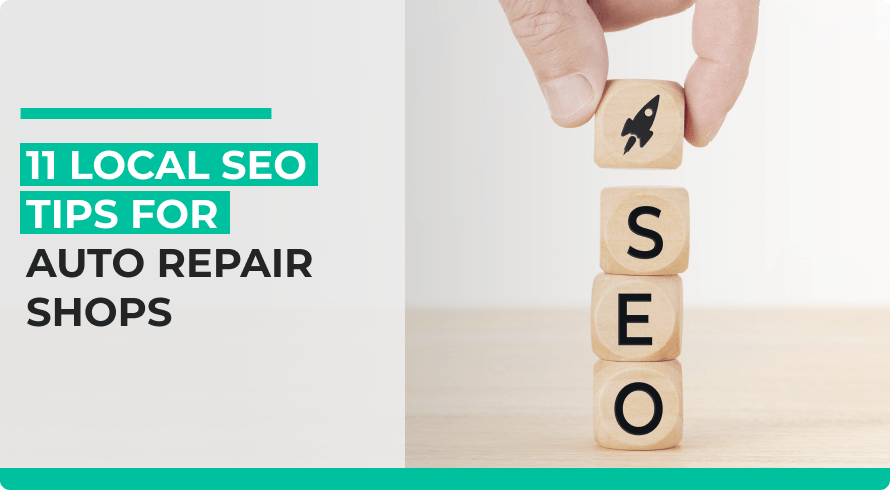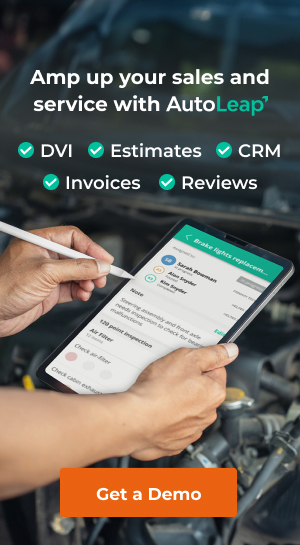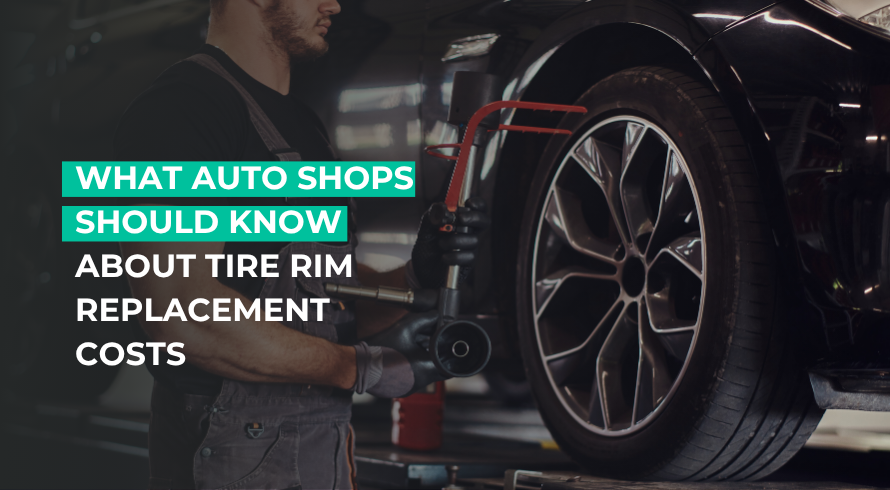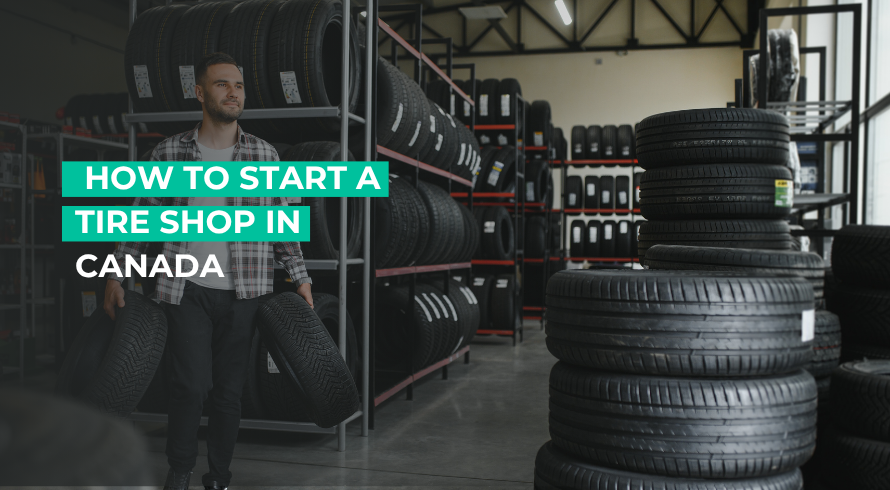Need to capitalize on local SEO for your auto repair shop? Local search is a powerful way to boost your business and target customers. Without local SEO, you are bound to lose potential customers. The best way to do this is through an effective SEO strategy.
But where to begin planning this strategy? It can be hard to figure out how to get a business ranked for something like auto repair!
Not to worry, we have you sorted. Everything you need to know has been synthesized in these eleven easy steps.
Let’s begin!
What is local SEO?
Before we begin, let’s establish what local SEO means.
“Local” is of course the area that is directly around you or a short distance away from you. Local “Search Engine Optimization”, or “SEO”, is simply the act of optimizing your business to rank high on search rankings. These rankings could come on Google, Bing, Yahoo or any other search engine.
Think of a search engine as a massive filing system. Based on the local search, the most relevant results will turn up through an algorithm. Your goal is to master this algorithm. This is done in order to generate local traffic and increase qualified customers.
Why is local SEO important?
It goes without saying, you need to direct both foot and virtual traffic to your business. Local SEO is now the primary way to do that. It is also the quickest and most efficient way to do so.
Not to mention, if you aren’t showing up high on search engines, that is definitely bad for business. Why?
There are 6.64 billion smartphone users worldwide – 83.37% of the world population. All these people use their phones to answer their next burning question. Additionally, 46% of these online searches are local. This makes it all the more important that businesses invest in local SEO and mobile optimization.

Source: BankMyCell
In short – you will definitely get a bang for your buck!
SEO research & planning
In layman terms, you need to make it easy for search engines to understand what your business/website is about. ‘Google bot’ scours the internet to segment and manage websites. It organizes relevant websites according to search terms. Then it ranks those websites that match these terms really well.
Statista reports that Google is the most popular search engine, accounting for over 80% of the search market share.
In order to get Google Bot to not only find your website but also rank it high, you need to follow some tips and tricks.
Step 1: Identify audience’s search intent
Put yourselves in the shoes of your customer. What is it they will look for? What might drive their search?
Think of the primary keyword they would use. Look for their key questions and use it in your content. You can do this through Google Search, and see what shows up in the Search Engine Results Page (SERP). Breeze over the ‘People Also Ask’ section, ‘Searches Related to’, ‘Images’ and ‘News’ sections. Some words will likely be similar across all of these.
You can also use Soovle to search across search engines and see what kind of words show up the most and where.
There will be some pressing concerns and questions your customers might have. You can use Answer the Public, Quora or Reddit to learn what these are. In doing so you will find related terms to your primary keyword.
For instance, maybe your customers are wondering why catalytic converters are stolen? How can they protect their catalytic converters? What is the process for running an engine diagnostic test?
Once you understand your customers queries and concerns, you will better be able to plan.
Step 2: Plan your keywords
Once you have determined the search intent, you will have a comprehensive list of keywords. You can’t simply throw all these words into your content. If only it was as simple as that.
You will have to undertake some more in-depth research. Here are four questions to ask when planning your shop’s keywords:
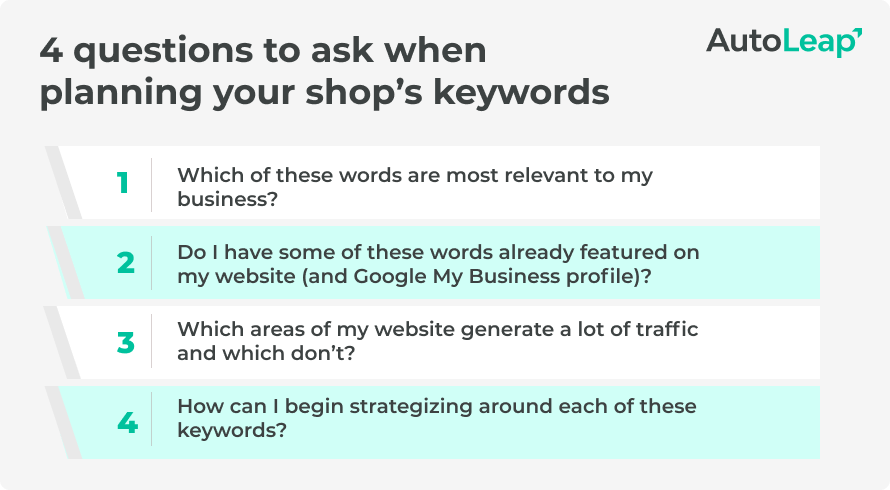
These target keywords are what you are looking for and need to use in your content.
You can use plug-ins such as SEOQuake or free & paid tools. These include Google Keyword Planner, Ahrefs & SEMrush. Using these tools will show you how much traffic each word you found generates.
This can help you prioritize some rather than all. You can then begin creating your content accordingly.
Once you map this out, you will have settled on your primary keywords. For each primary keyword, you will have some secondary keywords and sprinkle keywords. (More about these ahead).
Now you have to optimize for them in two places; your Google My Business page and your website.
Begin on-page SEO optimization
Step 3: Optimize your Google my Business profile
This option is probably the quickest and easiest way to establish SEO for auto repair shops. Because, let’s face it, people aren’t actively conducting a search unless they have an issue with their car.
If you aren’t already listed on Google, it’s time to do so. It’s free and you can manage your profile for the Google Search Console and Maps. If you are already on Google my Business listing you need to manage your profile to include the list of keywords you researched.
The “Map Pack” or “Local Pack” section of Google search, shows snapshots of three local businesses. These are pulled from Google Maps searches, and of course include the relevant keywords. However, it is important to remember that Map Packs have their own algorithms as well. Such as proximity to a location.
Sometimes the SERP shows you a map pack regardless of what you typed in. For instance, if someone just typed “auto repair shop” versus “auto repair shop near me” or “auto repair shop Chicago”, they might still get a display of a local pack.
Make sure that your GMB profile has correct information. This includes opening hours, holidays and other basic business info. These should be up-to-date and accurate. Though this does not directly impact search rankings, it ensures you are not left with a bad review if the information was incorrect.
Step 4: Time for website optimization
Even if you do not rank top in the Map Pack, showing up in the results below is also crucial. This is where local SEO for auto repair shops can get fun and creative!
Your website should be optimized to show up in general, local results. You already planned and have a better sense of keywords. You should now include these as your on-page SEO (i.e on your website). This means making sure your primary keyword is in the:
- Title
- URL
- Body text
- Meta tags
Pro tip: Keep conducting this keyword research to update and optimize your existing pages. At the same time, continue generating new content in order to become more discoverable. Blogs are the best way to do this. (Read on to learn more about this).
Step 5: Don’t forget keyword best practices
There are some best practices for including keywords as well. It can be very tricky. Here are some tips and tricks for you to follow!
1) Avoid keyword stuffing
It sounds easy to just add keywords everywhere on your page to optimize. However, there is a catch. If you add too many keywords, search engines will pick it up and not feature your content. This is called ‘keyword stuffing’. Avoid this approach and focus on creating valuable and relevant content.
2) Recommended amount of primary keywords
Two to three times minimum is the recommended amount your keyword should show on a webpage. For a regular blog, it can be three to five times.
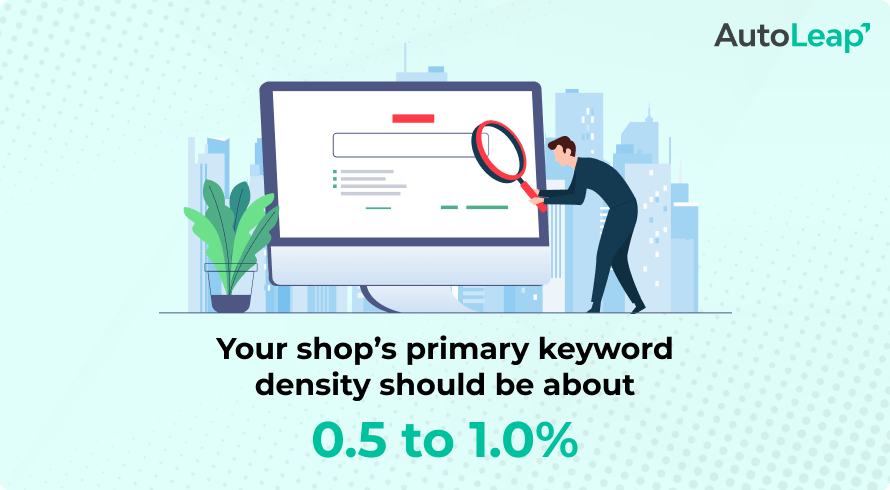
Source: Content Hero
According to Content Hero, the primary keyword density should be about 0.5 to 1.0% (1000 word blog – 5 to 10 times). That means you can include it in:
- The title
- First paragraph (preferably first sentence)
- Subheadings
- Last paragraph
You can then try to optimize pages by creating variations of that keyword. For longer content however, include a mix of keywords within headers and body copy.
Other than that, you can sprinkle other words used within your content that are relevant. Such as the words used in the “People Also Ask” section or the Google Images section. For instance, for “auto repair” you might see:
- What does auto repair mean?
- What is the most common repair on a car?
- What are the different car repairs?
- Logo
- Mechanic
- Garage
- Service
- Shop
For your secondary keywords, you can use them in the subheadings and body.
You can even use them when you feel like the primary keyword would look out of place or has been used enough.
Sprinkle keywords are what will appear in your body so that they also rank in the SERP.
3) Ensure good structure
You hate reading lengthy paragraphs, don’t you? Well so do your customers! This is why you have to make sure your content is easy to skim through. You want to give a good picture of your shop in an effective way.
Make sure the structure of your content is well designed. You want to relay your information effectively and efficiently. Without sounding confusing. Draw your audience in, not away. Too much text, unnecessary information or poor formatting can have a negative impact.
4) Content creation
Make sure you have high quality organic content! If you simply copy and paste content onto two of your websites, it will reduce your visibility on search engines. As a result, both websites’ SEO rankings will suffer.
Let’s say you have two different locations. Your content should be different for each location.
As we mentioned before, blogs are a great way for increasing visibility. What do blogs offer?
- They share relevant and helpful content
- Create engagement with audiences
- Are informative and advertise your product in a meaningful way
- Attract marketing qualified leads
- Build your brand and trust with clients
- Provide you with an opportunity for a call to action; such as “Sign Up” or “Request a Demo” or “Schedule an Appointment”
5) Title tags
Make sure to include your keyword in the title tag of your page. It should also be a strong, benefit driven statement. Some tips to help you do that.
- Be sure to match search intent
- Should be click worthy
- Must include the primary keyword
- Make use of your location-focused keyword
This could then look like:
- “Best Auto Repair Shop in Chicago”
- “Autor Repair Solutions in New York City”
- “X Myths About E.V’s Busted”
- “How to ..: A Beginner’s Guide”
- “…. : A Step by Step Guide”
- “Everything You Need To Know About …”
6) Optimize your meta descriptions
Your meta description gives a snapshot to your customer of what that particular page/article is about. You want to include the primary key word once here. Make sure it is snappy and catchy so that the customer is sure to click.
Some tips for writing your meta description:
- Matches search intent
- Communicates value
- Uses action words
- Includes target keywords
- You should think like a copywriter
7) Keep tracking
Use Google Analytics and keep tracking your website for traffic. Which pages tend to generate a lot more heat? What are some of the words being used there?
Is your page NOT generating the traffic you expected? Then maybe you need to look into your keyword strategy again.
Off page SEO & link building campaign
Apart from establishing local SEO for your auto repair business, you have to use off page SEO as well. This means establishing credibility for your website/Google My Business profile through backlink and reviews.
Creating a link building campaign is crucial. It helps:
- Raise awareness about your brand
- Increases legitimacy in the eyes of customers
- Increases SEO rankings
- Builds relationships
Step 6: Ensuring NAP citations
NAP stands for your Name, Address and Phone Number. Apart from your GMB profile, the more websites that cite your NAP the more credibility that you exist. That is why you can ask other websites to list your name and address such as Yelp.
Google ascertains that your business info is correct through NAPs. The more Google Bot sees NAP citations for your business, the more confident it is that your address and phone number are correct.
Consistency is key. So you must make sure that your address is consistent throughout NAP citations.
Step 7: Creating backlinks
Think of the internet as one big city that is connected through roads. These roads connect houses (i.e your website) to offices, shops and other houses. The better connected the roads are, the more easily you can get to your destination.

So if other sites create an outbound link from their website to yours, you are building a greater connection across the internet. This gives your business more credibility, and makes it more discoverable.
The best citation opportunities are with local sites. These are super relevant citations that can boost your Map Pack rankings. Local businesses have a strong tie to a specific city or state. This creates a unique opportunity for unique backlinks. Something non-local sites cannot tap into.
For instance, if you are an auto repair shop, maybe collaborate with a local car dealer. The car dealer can recommend your shop for all auto repairs, while you can recommend them for purchasing new cars. You can create links within your Google business profiles or websites.
Not sure how to find local sites for citations? Just use the Backlink Gap feature in Semrush! It works for link building and citations too.
Another way to create good backlinks is:
- Sponsor a local competition
- Make a donation to a local charity
- Partake in a local event
When you do this, the individual website will display your business, and link to your website.
Step 8: Generate some reviews
Moz, a Domain Authority website, discovered having positive local reviews can improve your business’ ranking on search engines. About 15.44% of SEO rankings are accounted for by online reviews. These reviews are considered by quantity, quality and diversity.
Review sites are also a great way to create further backlinks. Without a doubt, the more five-star reviews you have, the higher the likelihood a person will visit your shop. The more recent the reviews, the better.
Step 9: Respond to reviews
Customers simply leaving a review is not enough. You as an owner should respond to this feedback. Whether a review is negative or positive, your response will also determine SEO rankings. This is organic and valuable content.
Step 10: Take to forums
It is important to answer auto repair queries on forums such as Reddit, Sub Reddit, Quora,Yahoo Answers, etc. Pick a platform that has high authority and is relevant. Look for your particular niche and related questions. Make sure you answer them in a manner that does not look like spam. You want to add value to the question.
You could potentially have a guide or how -to article already published. Link it to your answer so that people can easily locate your content as well. If you do this well, this strategy can be a game-changing off-page SEO tactic.
Step 11: Establish a stellar social media presence
It is forecasted that 4.41 billion users will find themselves on social media by 2025. This is a space you need to tap into. The top social media platforms include:
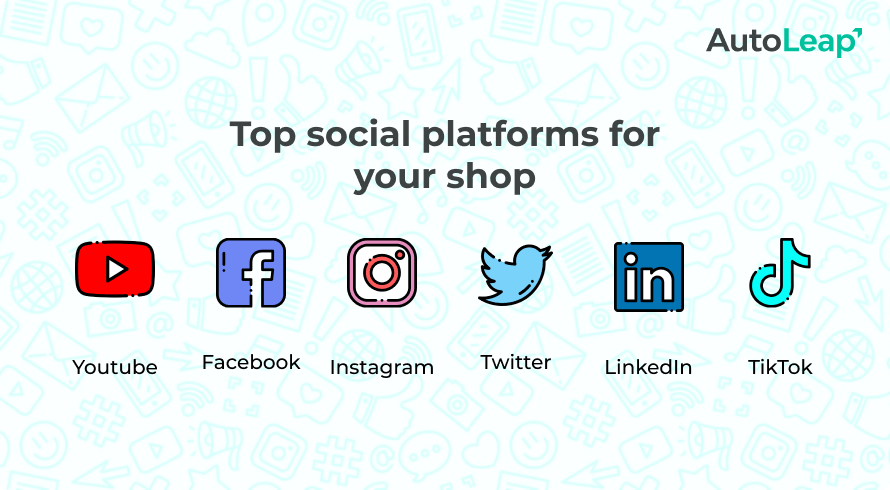
It is in this space you can truly interact with you and build a sense of trust. Posting to social media, you can create content that can be shared and used by others as well. Be it infographics or facts.
Perhaps you can create a DIY video about how to build your own engine that can be shared on YouTube. Instagram has become a sphere of inspiration. With a great love for cars worldwide, you can post aesthetic photos of various cars and increase your following.
Reels are also a great way to pass information in an efficient manner. You can share information about your automobile repair shop in fun and creative ways.
You can then add your posts to your GMB profile. These will show up on SERP.
» Looking to streamline your operations? Discover how our auto shop management software can help.
Closing thoughts
Before we forget, make sure your website is mobile friendly! It would be an awful blunder should you put all this effort and have it backfire.
Hopefully these eleven easy local SEO tips for auto repair shops are a good stepping stone to establish a strong local SEO strategy for your business.

